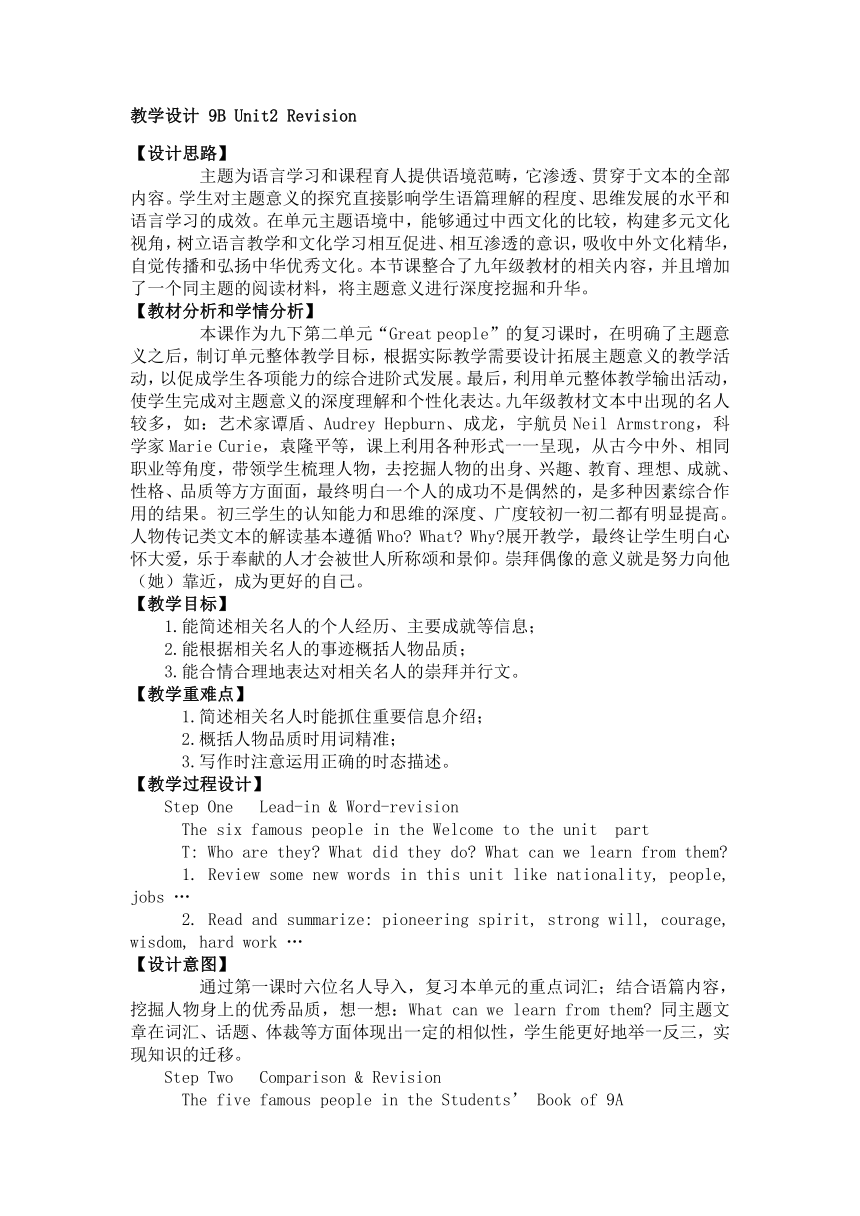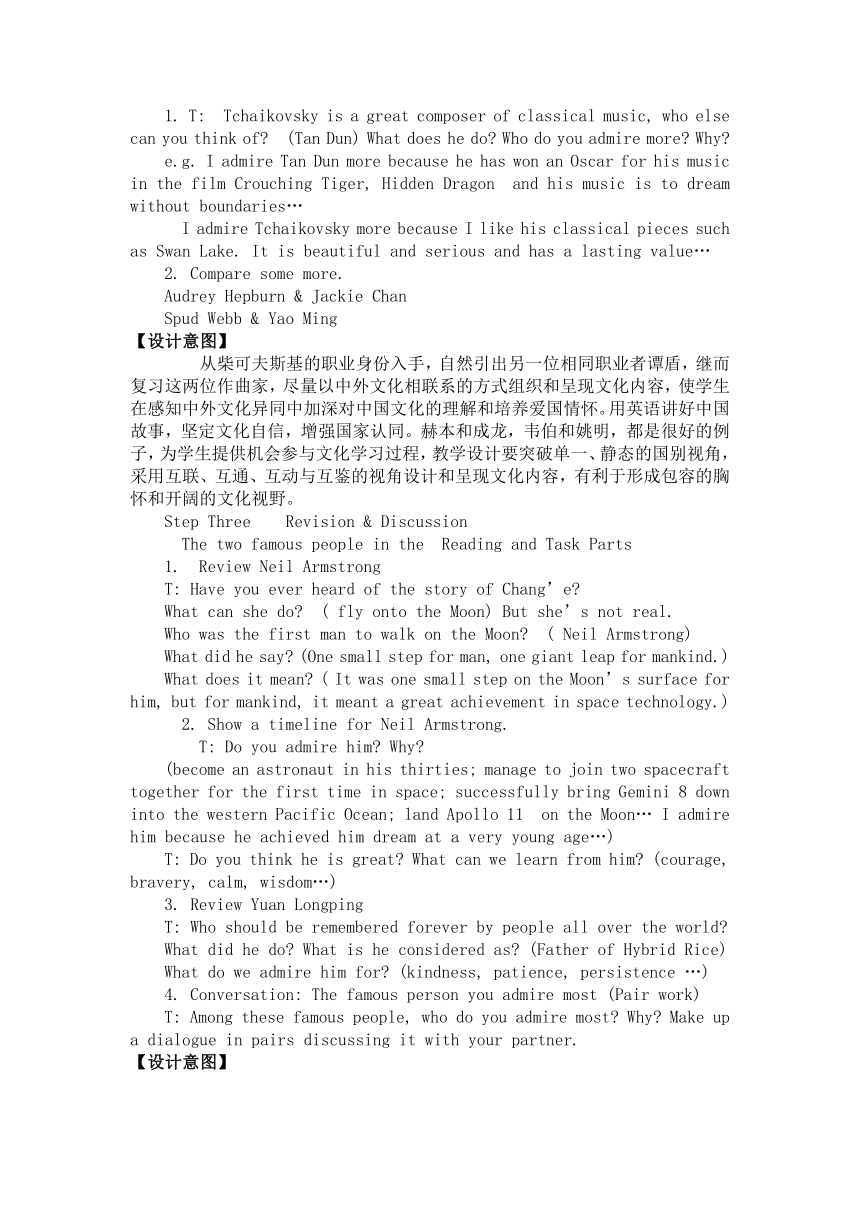Unit 2 Great people Revision教学设计2023-2024学年牛津译林版英语九年级下册
文档属性
| 名称 | Unit 2 Great people Revision教学设计2023-2024学年牛津译林版英语九年级下册 |

|
|
| 格式 | docx | ||
| 文件大小 | 23.6KB | ||
| 资源类型 | 教案 | ||
| 版本资源 | 牛津译林版 | ||
| 科目 | 英语 | ||
| 更新时间 | 2024-04-16 13:27:00 | ||
图片预览


文档简介
教学设计 9B Unit2 Revision
【设计思路】
主题为语言学习和课程育人提供语境范畴,它渗透、贯穿于文本的全部内容。学生对主题意义的探究直接影响学生语篇理解的程度、思维发展的水平和语言学习的成效。在单元主题语境中,能够通过中西文化的比较,构建多元文化视角,树立语言教学和文化学习相互促进、相互渗透的意识,吸收中外文化精华,自觉传播和弘扬中华优秀文化。本节课整合了九年级教材的相关内容,并且增加了一个同主题的阅读材料,将主题意义进行深度挖掘和升华。
【教材分析和学情分析】
本课作为九下第二单元“Great people”的复习课时,在明确了主题意义之后,制订单元整体教学目标,根据实际教学需要设计拓展主题意义的教学活动,以促成学生各项能力的综合进阶式发展。最后,利用单元整体教学输出活动,使学生完成对主题意义的深度理解和个性化表达。九年级教材文本中出现的名人较多,如:艺术家谭盾、Audrey Hepburn、成龙,宇航员Neil Armstrong,科学家Marie Curie,袁隆平等,课上利用各种形式一一呈现,从古今中外、相同职业等角度,带领学生梳理人物,去挖掘人物的出身、兴趣、教育、理想、成就、性格、品质等方方面面,最终明白一个人的成功不是偶然的,是多种因素综合作用的结果。初三学生的认知能力和思维的深度、广度较初一初二都有明显提高。人物传记类文本的解读基本遵循Who What Why 展开教学,最终让学生明白心怀大爱,乐于奉献的人才会被世人所称颂和景仰。崇拜偶像的意义就是努力向他(她)靠近,成为更好的自己。
【教学目标】
1.能简述相关名人的个人经历、主要成就等信息;
2.能根据相关名人的事迹概括人物品质;
3.能合情合理地表达对相关名人的崇拜并行文。
【教学重难点】
1.简述相关名人时能抓住重要信息介绍;
2.概括人物品质时用词精准;
3.写作时注意运用正确的时态描述。
【教学过程设计】
Step One Lead-in & Word-revision
The six famous people in the Welcome to the unit part
T: Who are they What did they do What can we learn from them
1. Review some new words in this unit like nationality, people, jobs …
2. Read and summarize: pioneering spirit, strong will, courage, wisdom, hard work …
【设计意图】
通过第一课时六位名人导入,复习本单元的重点词汇;结合语篇内容,挖掘人物身上的优秀品质,想一想:What can we learn from them 同主题文章在词汇、话题、体裁等方面体现出一定的相似性,学生能更好地举一反三,实现知识的迁移。
Step Two Comparison & Revision
The five famous people in the Students’ Book of 9A
1. T: Tchaikovsky is a great composer of classical music, who else can you think of (Tan Dun) What does he do Who do you admire more Why
e.g. I admire Tan Dun more because he has won an Oscar for his music in the film Crouching Tiger, Hidden Dragon and his music is to dream without boundaries…
I admire Tchaikovsky more because I like his classical pieces such as Swan Lake. It is beautiful and serious and has a lasting value…
2. Compare some more.
Audrey Hepburn & Jackie Chan
Spud Webb & Yao Ming
【设计意图】
从柴可夫斯基的职业身份入手,自然引出另一位相同职业者谭盾,继而复习这两位作曲家,尽量以中外文化相联系的方式组织和呈现文化内容,使学生在感知中外文化异同中加深对中国文化的理解和培养爱国情怀。用英语讲好中国故事,坚定文化自信,增强国家认同。赫本和成龙,韦伯和姚明,都是很好的例子,为学生提供机会参与文化学习过程,教学设计要突破单一、静态的国别视角,采用互联、互通、互动与互鉴的视角设计和呈现文化内容,有利于形成包容的胸怀和开阔的文化视野。
Step Three Revision & Discussion
The two famous people in the Reading and Task Parts
1. Review Neil Armstrong
T: Have you ever heard of the story of Chang’e
What can she do ( fly onto the Moon) But she’s not real.
Who was the first man to walk on the Moon ( Neil Armstrong)
What did he say (One small step for man, one giant leap for mankind.)
What does it mean ( It was one small step on the Moon’s surface for him, but for mankind, it meant a great achievement in space technology.)
2. Show a timeline for Neil Armstrong.
T: Do you admire him Why
(become an astronaut in his thirties; manage to join two spacecraft together for the first time in space; successfully bring Gemini 8 down into the western Pacific Ocean; land Apollo 11 on the Moon… I admire him because he achieved him dream at a very young age…)
T: Do you think he is great What can we learn from him (courage, bravery, calm, wisdom…)
3. Review Yuan Longping
T: Who should be remembered forever by people all over the world
What did he do What is he considered as (Father of Hybrid Rice)
What do we admire him for (kindness, patience, persistence …)
4. Conversation: The famous person you admire most (Pair work)
T: Among these famous people, who do you admire most Why Make up a dialogue in pairs discussing it with your partner.
【设计意图】
复习本单元Reading和Task课时的两位名人,一位是“仰望星空,飞天登月”第一人,一位是“脚踏实地,为民造福”的水稻科学家,都是对世界产生重大影响的时代英雄,从他们身上可以学到很多,值得我们从不同的角度去分析人物性格、探讨人物的突出品质。这个环节之后,紧接着将之前出现的所有人物进行了汇总,让学生小组合作,说说“最崇拜的名人”,水到渠成地实现了“名人墙”的复刻和精神升华,启迪和照亮了每个人的心灵。
Step Four Revision & Presentation
The great scientist in the Integrated skills Part
1. Review Marie Curie
T: Of all the famous people, who won the Nobel Prize twice (Marie Curie)
How much do you know about her (discover …, push for …)
What can we learn from her
2. A presentation on another female scientist --Tu Youyou
T: Do you know the first Chinese woman to win the Nobel Prize
What did she discover (Qinghaosu)
Read a profile card about Tu Youyou and learn about malaria and Qinghaosu.
Fill in the blanks and say something about Tu’s contributions.
【设计意图】
复习综合技能课时里的居里夫人,发现了化学元素“镭”,两次获“诺奖”,学习她无私忘我、为科学献身的精神。再用“诺奖”巧过渡,引出中国第一位获“诺奖”的女药学家——屠呦呦。通过了解屠呦呦的个人经历和主要事迹,自觉运用本单元新学词汇来扩充口头表达的“语料库”,提高人物理解力和语用能力。同时,帮助学生建立民族自豪感,激发学习和传播中国文化的热情。新课程倡导教师“用教材”而不是“教教材”,所以教师需要融入自己的教学思路,研读教学的逻辑起点,对教材的文本内容进行重组、整合、拓展和深加工,以期创造性地使用教材。
Step Five Analysis & Writing
1. Review uses of different tenses (the Grammar part in this unit)
l people who passed away
what he / she did (experiences, achievements …) simple past tense
what people think of him / her (comments) simple past/ present tense
l people who are alive
what he / she did
what he /she has done (experiences, achievements …) different tenses
what he / she does
what people think of him / her (comments) simple present tense
2. Writing: The famous person I admire most
Who Introduction (name, title, …)
What Further information about his / her life (education, achievements, …)
Why Reasons why I admire him / her
【设计意图】
充分锻炼了口头表达之后,思维得到了碰撞和启发,最终落实到“写”的环节。对于已故名人和在世名人的写作时态,学生容易混淆不清,特此举例说明,力求表达准确,涉及到了本单元语法项目——不同时态的复习。围绕话题“我最崇拜的名人”,运用本课复习和新学到的语言知识,通过Who—What—Why三部分来行文。书面表达有助于学生关联自己的认知和生活,形成一种自我感知力,实现深度学习和自我教育。
Step Six Discussion & Homework
1. Thinking
T: Undoubtedly, all these people that we have just talked about make a great difference to the whole world and society. In your opinion, what makes great people What makes people great
( interest, talent, education, thoughts, attitude, actions … achievements)
Don’t tell your dreams, show them with actions!
One small step for you today, one giant leap for you tomorrow!
2. Homework
Watch the documentary about Tu Youyou.
Finish writing and review the whole unit.
【设计意图】
基于主题意义的文本解读,落脚点是学生,运用文本这个例子,实现学生的培养和发展。根据文本解读的开放性、多元化和个性化的特点,培养学生的思维品质和精神品质。只有善于引导学生将学习后的主观感受与知识、与过去经历、与当今世界联结,才能培养学生的系统性思维,实现将“人为”的文本转变成“为人”的生活态度这个最终目的。探讨“What makes great people ”的意义不在于一定要成为伟人这个终极性评价,而在于见贤思齐,通过努力超越自我。课后作业的设计呼应教学目标、指向应用,有着拓展延伸、培养发展、反馈交流等功能。
【设计思路】
主题为语言学习和课程育人提供语境范畴,它渗透、贯穿于文本的全部内容。学生对主题意义的探究直接影响学生语篇理解的程度、思维发展的水平和语言学习的成效。在单元主题语境中,能够通过中西文化的比较,构建多元文化视角,树立语言教学和文化学习相互促进、相互渗透的意识,吸收中外文化精华,自觉传播和弘扬中华优秀文化。本节课整合了九年级教材的相关内容,并且增加了一个同主题的阅读材料,将主题意义进行深度挖掘和升华。
【教材分析和学情分析】
本课作为九下第二单元“Great people”的复习课时,在明确了主题意义之后,制订单元整体教学目标,根据实际教学需要设计拓展主题意义的教学活动,以促成学生各项能力的综合进阶式发展。最后,利用单元整体教学输出活动,使学生完成对主题意义的深度理解和个性化表达。九年级教材文本中出现的名人较多,如:艺术家谭盾、Audrey Hepburn、成龙,宇航员Neil Armstrong,科学家Marie Curie,袁隆平等,课上利用各种形式一一呈现,从古今中外、相同职业等角度,带领学生梳理人物,去挖掘人物的出身、兴趣、教育、理想、成就、性格、品质等方方面面,最终明白一个人的成功不是偶然的,是多种因素综合作用的结果。初三学生的认知能力和思维的深度、广度较初一初二都有明显提高。人物传记类文本的解读基本遵循Who What Why 展开教学,最终让学生明白心怀大爱,乐于奉献的人才会被世人所称颂和景仰。崇拜偶像的意义就是努力向他(她)靠近,成为更好的自己。
【教学目标】
1.能简述相关名人的个人经历、主要成就等信息;
2.能根据相关名人的事迹概括人物品质;
3.能合情合理地表达对相关名人的崇拜并行文。
【教学重难点】
1.简述相关名人时能抓住重要信息介绍;
2.概括人物品质时用词精准;
3.写作时注意运用正确的时态描述。
【教学过程设计】
Step One Lead-in & Word-revision
The six famous people in the Welcome to the unit part
T: Who are they What did they do What can we learn from them
1. Review some new words in this unit like nationality, people, jobs …
2. Read and summarize: pioneering spirit, strong will, courage, wisdom, hard work …
【设计意图】
通过第一课时六位名人导入,复习本单元的重点词汇;结合语篇内容,挖掘人物身上的优秀品质,想一想:What can we learn from them 同主题文章在词汇、话题、体裁等方面体现出一定的相似性,学生能更好地举一反三,实现知识的迁移。
Step Two Comparison & Revision
The five famous people in the Students’ Book of 9A
1. T: Tchaikovsky is a great composer of classical music, who else can you think of (Tan Dun) What does he do Who do you admire more Why
e.g. I admire Tan Dun more because he has won an Oscar for his music in the film Crouching Tiger, Hidden Dragon and his music is to dream without boundaries…
I admire Tchaikovsky more because I like his classical pieces such as Swan Lake. It is beautiful and serious and has a lasting value…
2. Compare some more.
Audrey Hepburn & Jackie Chan
Spud Webb & Yao Ming
【设计意图】
从柴可夫斯基的职业身份入手,自然引出另一位相同职业者谭盾,继而复习这两位作曲家,尽量以中外文化相联系的方式组织和呈现文化内容,使学生在感知中外文化异同中加深对中国文化的理解和培养爱国情怀。用英语讲好中国故事,坚定文化自信,增强国家认同。赫本和成龙,韦伯和姚明,都是很好的例子,为学生提供机会参与文化学习过程,教学设计要突破单一、静态的国别视角,采用互联、互通、互动与互鉴的视角设计和呈现文化内容,有利于形成包容的胸怀和开阔的文化视野。
Step Three Revision & Discussion
The two famous people in the Reading and Task Parts
1. Review Neil Armstrong
T: Have you ever heard of the story of Chang’e
What can she do ( fly onto the Moon) But she’s not real.
Who was the first man to walk on the Moon ( Neil Armstrong)
What did he say (One small step for man, one giant leap for mankind.)
What does it mean ( It was one small step on the Moon’s surface for him, but for mankind, it meant a great achievement in space technology.)
2. Show a timeline for Neil Armstrong.
T: Do you admire him Why
(become an astronaut in his thirties; manage to join two spacecraft together for the first time in space; successfully bring Gemini 8 down into the western Pacific Ocean; land Apollo 11 on the Moon… I admire him because he achieved him dream at a very young age…)
T: Do you think he is great What can we learn from him (courage, bravery, calm, wisdom…)
3. Review Yuan Longping
T: Who should be remembered forever by people all over the world
What did he do What is he considered as (Father of Hybrid Rice)
What do we admire him for (kindness, patience, persistence …)
4. Conversation: The famous person you admire most (Pair work)
T: Among these famous people, who do you admire most Why Make up a dialogue in pairs discussing it with your partner.
【设计意图】
复习本单元Reading和Task课时的两位名人,一位是“仰望星空,飞天登月”第一人,一位是“脚踏实地,为民造福”的水稻科学家,都是对世界产生重大影响的时代英雄,从他们身上可以学到很多,值得我们从不同的角度去分析人物性格、探讨人物的突出品质。这个环节之后,紧接着将之前出现的所有人物进行了汇总,让学生小组合作,说说“最崇拜的名人”,水到渠成地实现了“名人墙”的复刻和精神升华,启迪和照亮了每个人的心灵。
Step Four Revision & Presentation
The great scientist in the Integrated skills Part
1. Review Marie Curie
T: Of all the famous people, who won the Nobel Prize twice (Marie Curie)
How much do you know about her (discover …, push for …)
What can we learn from her
2. A presentation on another female scientist --Tu Youyou
T: Do you know the first Chinese woman to win the Nobel Prize
What did she discover (Qinghaosu)
Read a profile card about Tu Youyou and learn about malaria and Qinghaosu.
Fill in the blanks and say something about Tu’s contributions.
【设计意图】
复习综合技能课时里的居里夫人,发现了化学元素“镭”,两次获“诺奖”,学习她无私忘我、为科学献身的精神。再用“诺奖”巧过渡,引出中国第一位获“诺奖”的女药学家——屠呦呦。通过了解屠呦呦的个人经历和主要事迹,自觉运用本单元新学词汇来扩充口头表达的“语料库”,提高人物理解力和语用能力。同时,帮助学生建立民族自豪感,激发学习和传播中国文化的热情。新课程倡导教师“用教材”而不是“教教材”,所以教师需要融入自己的教学思路,研读教学的逻辑起点,对教材的文本内容进行重组、整合、拓展和深加工,以期创造性地使用教材。
Step Five Analysis & Writing
1. Review uses of different tenses (the Grammar part in this unit)
l people who passed away
what he / she did (experiences, achievements …) simple past tense
what people think of him / her (comments) simple past/ present tense
l people who are alive
what he / she did
what he /she has done (experiences, achievements …) different tenses
what he / she does
what people think of him / her (comments) simple present tense
2. Writing: The famous person I admire most
Who Introduction (name, title, …)
What Further information about his / her life (education, achievements, …)
Why Reasons why I admire him / her
【设计意图】
充分锻炼了口头表达之后,思维得到了碰撞和启发,最终落实到“写”的环节。对于已故名人和在世名人的写作时态,学生容易混淆不清,特此举例说明,力求表达准确,涉及到了本单元语法项目——不同时态的复习。围绕话题“我最崇拜的名人”,运用本课复习和新学到的语言知识,通过Who—What—Why三部分来行文。书面表达有助于学生关联自己的认知和生活,形成一种自我感知力,实现深度学习和自我教育。
Step Six Discussion & Homework
1. Thinking
T: Undoubtedly, all these people that we have just talked about make a great difference to the whole world and society. In your opinion, what makes great people What makes people great
( interest, talent, education, thoughts, attitude, actions … achievements)
Don’t tell your dreams, show them with actions!
One small step for you today, one giant leap for you tomorrow!
2. Homework
Watch the documentary about Tu Youyou.
Finish writing and review the whole unit.
【设计意图】
基于主题意义的文本解读,落脚点是学生,运用文本这个例子,实现学生的培养和发展。根据文本解读的开放性、多元化和个性化的特点,培养学生的思维品质和精神品质。只有善于引导学生将学习后的主观感受与知识、与过去经历、与当今世界联结,才能培养学生的系统性思维,实现将“人为”的文本转变成“为人”的生活态度这个最终目的。探讨“What makes great people ”的意义不在于一定要成为伟人这个终极性评价,而在于见贤思齐,通过努力超越自我。课后作业的设计呼应教学目标、指向应用,有着拓展延伸、培养发展、反馈交流等功能。
